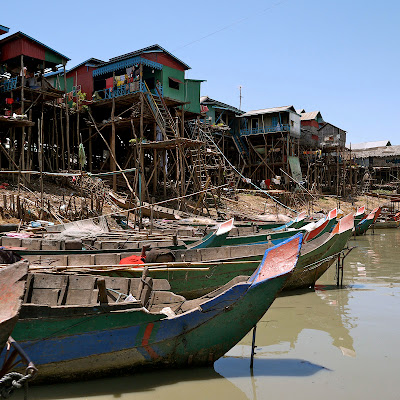My first day in Siem Reap, I decided to visit the floating villages of Chong Kneas. Unlike Bangkok, the floating villages are a place where families live, and not just sell goods. According to my boat guide, there are about 6000 inhabitants of the first village I visited. With an average of 7-10 people living in one boathouse; typically 5 children, 2 parents, and possibly the grandparents. 90% of the people who live in this village are fishermen. It is currently the dry season, so the waters are about 1 meter deep, but during the rainy season, the waters can be up to 10 meters deep. Because the water is so low, the fishing is very abundant during this time of year. Currently the price of fish is very low at the markets, because there are so many to be had. I was told year in particular has been very good for fishing.
Everything can be found within these villages; school, basketball court, store, restaurant, an orphanage, etc. We visited one floating restaurant that was run for tourists. It had an crocodile farm within its premises, and you could get your picture taken with a snake (ugh... no way!).
Since the waters are so low during this time of year, you can see children or adults climbing in and out of the waters, walking around on the lake floor to do repairs on their boats, or other tasks. The waters are about chest level of most adults. At one point our boat became untied from the restaurant we were visiting and the "boat boy", quickly tore off his clothes, jumped into the browny waters and fetched the boat for our driver.
 |
| On route to the floating villages, which are seen along the horizon. |
 |
| How many Cambodian's can you fit into a boat? |
The second floating village I visited was Kompong Pluk, where the houses are built on "land" with long stilts. It is an other-worldly place. Most of the houses are almost bamboo skyscrapers and it looks like its straight out of a film set. The houses are located on a river which leads out to the nearby lake. Apparently the waters of the river during the rainy season come almost right up to the floors of the houses. While I was visiting the water was incredibly low, and we had difficulty navigating between the boats due to the lack of water. The river was about 5 meters wide, with boats docked on either side; not leaving much room to maneuver between as we made our way out to the lake. I enjoyed this village more than the first, as there were far less tourists (aka Japanese tourists, armed with cameras) and it was so unique! The houses look so unstable on their foundations I wonder if any topple over during the dry season.
 |
| I was the only tourist on this boat... besides the boat driver and Ruthi my driver |
 |
| Imagine bringing groceries up these stairs? |
 |
| The "bushes" you see on land, are actually nets. The fish swim into the bush and get caught. The fishermen lift them out of the water and empty out the fish. |
After the morning of floating villages, I grew tired of the heat. Since it is the dry season, the temperatures are balmy 35-40 celsius. I retired for the afternoon at my hotel. Much like the roads in Sri Lanka, the roads in this area of Cambodia are very dusty, and I had to scrub down after being on a motorcycle for most of the morning.... even making sure to clean behind my ears. Its a dusty adventure on a motorcycle!









No comments:
Post a Comment